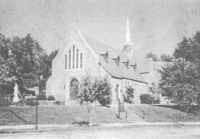
The current flock of Father David McGuire’s parish who celebrate the Mass in a Gothic-windowed brick building with slate roof in the city’s West End continues the tradition of faith which has flourished from the early services celebrated in Mr. Kelley’s tailor shop in 1875. The parishioner count today exceeds 1, 1 74 souls, many of whom have come from foreign countries and during migrations from the North in the wake of Danville’s industrial expansions beginning in the I 960s. According to church history, the fourth Bishop of Richmond, James Gibbons, later Cardinal Archbishop of Baltimore, in an early 1876 visit, lectured to quite a respectable audience, most of whom where Protestants. It was then arranged that Catholics should be visited monthly from Lynchburg by Father Patrick Donahoe. In 1 878, the parish was canonically erected with Father Habets as the first pastor. On land donated by Mr. Moore at the intersection of Ross and Holbrook streets, a Carpenter Italianate-style church was dedicated in 1879.
As the parish community prospered, Father Augustus Halbleib, a prolific author, raised $66,000 for the construction of the architecturally complex but well- balanced sanctuary sited on the small triangular lot at the intersection of West Main and Randolph streets. It was designed by the Staunton, Virginia, architect Samuel I. Collins.
This writers personal recollections of Catholicism in 1950 in Danville focus around the twelfth pastor, Father Vernon J. Bowers, a visionary minister to the faithful, who in 1953 fulfilled the dream of Sacred Heart by founding a parish school just up West Main Street in the antebellum Waddill House, later demolished for the construction of the Averett College library. Sacred Heart School, true to its beliefs, became the first school in Danville to achieve integration during the tense years of the civil rights movement.
In 1980, during Vatican II, the interior of the church was changed forever with the liturgical design of granite furnishings and the removal of the original stained glass windows. A tracker-action pipe organ built in 1875 by William B. Simmons of Boston was installed during this renovation. The Victorian decorative stencils on the thirty-one zinc case pipes were painted by Danville artist, Cynthia Durham. The organ’s manual keys are ivory and ebony with a pedal clavier of cherry and walnut.
The Stations of the Cross, which mark the journey from Pilate’s courtyard to Mount Calvary in a popular devotion from the Middle Ages, are authentic wood carvings from Oberammergau, Germany. The many Gothic arches of the interior are copied from the French Cathedral of Albi as is the exterior brickwork.
As Advent commences on December 1, the sanctuary is lit by the Advent candle but not until after the fourth Sunday of Advent on December 22 is the church decorated for the season in preparation for the Christmas Mass, a holy day of obligation for Catholics worldwide. The church remains decorated until the Epiphany celebration on January 6, 1997.